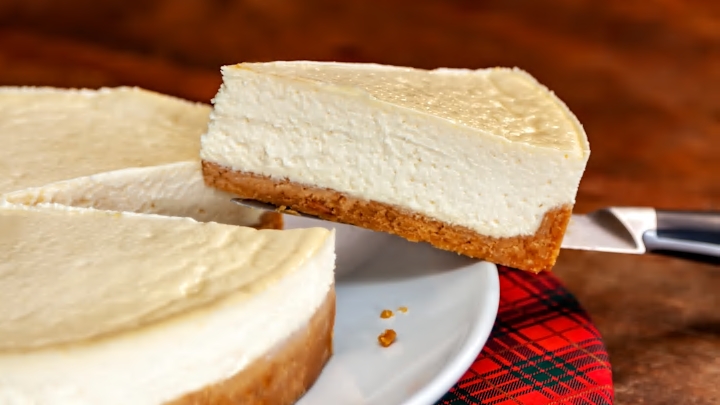As the Golden Girls were well aware, cheesecake can solve a lot of problems. It’s one of the most popular desserts in America—a decadent concoction of cream cheese, sugar, and graham cracker crust. The Cheesecake Factory built a brand on it.
But a question lingers: Why are some cheesecakes described as being “New York-style”? What’s the difference between non-urban cheesecake and conventional cheesecake? Should you reject any that’s not geographically identified?
Say Cheesecake
Cheesecake enthusiasts have German immigrants to thank for bringing the dessert to the States, though it looked slightly different when it arrived in the mid-19th century. That cheesecake was made with cottage cheese instead of cream cheese and a pastry-style crust instead of a crunchy, crushed cookie or graham cracker base.
According to New York Times columnist Eric Kim, at roughly the same time cheesecake was appearing on after-dinner plates, dairy manufacturer William Lawrence was refining Philadelphia cream cheese, a smooth version of a crumbly French cheese. Despite the name, it originated and was made in New York. (Associating it with Philadelphia, known for its dairy, gave it legitimacy.)
These two things—German cheesecake and cream cheese—converged in the 1930s, when owners of Jewish bakeries and delis in New York City began substituting cream cheese for the cottage cheese found in German recipes. The switch necessitated a new designation: New York-style cheesecake was cheesecake with a cream cheese base, a modification that’s since become widely popular.
But that’s not the only thing that makes for a classic New York cheesecake.

New York Cheesecake, Defined
New York cheesecake may be definitive for some, but it’s far from the only type of cheesecake available. What sort of cheesecake you consume comes down to three basic choices: the cheese, the crust, and whether it’s baked.
Italian cheesecake, for example, uses ricotta cheese and is baked; Chicago-style cheesecake adds sour cream or extra cream cheese. Some no-bake recipes use gelatin to set the cheesecake; contemporary German-style cheesecake uses quark, similar to sour cream with a taste like yogurt; Pennsylvania Dutch-style can be baked in a square pan with fruit as a bottom layer; Japanese cheesecake adds cornstarch.
A New York cheesecake is more likely to adhere to the following: In addition to a cream cheese base, it incorporates eggs, lemon, vanilla, and a graham cracker crust. It’s baked in a pan surrounded by a hot water bath to prevent overcooking. Devotees may also insist it “sit” and age for a few days before being served. For some, toppings are off-limits: A chocolate or strawberry syrup drizzle might offend purists.
Some deviations are permitted—one recipe might use heavy cream or sour cream in addition to cream cheese, while another might not—but that’s broadly the type of no-frills cheesecake that can garner a New York-style classification. The end result is a dense and smooth texture; other styles, like Chicago’s, might be fluffier. If a cheesecake sits solidly on your spoon, it’s probably New York-style. If it wiggles, it’s likely another variety.
There's some room for creativity. Junior’s uses a New York-style base but swaps out a graham cracker crust for sponge cake. That may be sacrilege to some, but Junior’s sells 5 million cheesecakes annually.
All cheesecakes, however, might arguably descend from Greek culture. One early version of a sweetened cheese “mass” was reportedly served to Olympic athletes at the first games in 776 BCE.
Get Answers to More Big Questions About Food:
